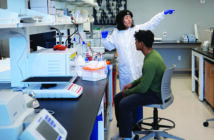Body of Evidence
People die in lots of different ways, but when a death is violent, suspicious, or unexplained, a forensic pathologist, also known as a medical examiner, is called on to investigate. Through death scene investigation, medical records review, autopsy, and toxicological, radiological, and other types of analyses, the ME aims to determine the manner, cause, and (to the extent possible) time of death. In Banerjee’s words, an ME is “a doctor who objectively applies their medical knowledge of disease in the context of death.”
In Mauriello’s estimation, it’s more than that.
“It’s easy to say ‘The cause of death was this or that,’ but how does that help the investigator?” he says. “Priya’s not just a good physician, she has good critical thinking and investigative skills too.”
To date, Banerjee has performed some 3,000 autopsies, including more than 160 homicide cases. But when she started medical school at the University of Pennsylvania, she didn’t yet know what kind of doctor she wanted to be. She had done basic science research at the National Institutes of Health for several summers and was good at it, but the work “just seemed too far removed to be purposeful. It wasn’t how my mind thrived,” she says. She enjoyed GI diseases, but knew she didn’t want to become a surgeon. Then she did a pathology rotation.
“I thought, ‘Everybody’s happy here. They’re solving puzzles, using all these tools and diagnosing diseases,’” she says. She asked to spend a week working in Philadelphia’s very busy Office of the Medical Examiner. That experience, which she describes as “awesome,” placed her squarely on her career path.
“Most people, even pathologists, hate autopsies,” she says. “They say, ‘It’s disgusting, it smells.’ But to me it’s like putting a puzzle together.”
Banerjee, whose Twitter bio declares, “I speak for the dead and teach the living,” has been helping solve death-related puzzles for more than two decades. As an assistant medical examiner for the State of Rhode Island starting in 2010, she worked on many locally known cases, including that of the murder of Captain Freddy, a 70-year-old veteran from Warwick, whose partially
“ Most people, even pathologists, hate autopsies. They say, ‘it’s disgusting, it smells.’ But to me it’s like putting puzzle together.”
skeletonized remains were found in his boat in 2015; and of Krystal Boswell, a young woman who was killed and buried near a vacant house in Cranston, in 2017. Banerjee was on call every third week, which was stressful: “Bad things don’t happen in the afternoon, they happen in the middle of the night.” And while performing an autopsy doesn’t bother her—“You’re just doing the case, collecting data”—she found investigating a death scene could be hard, especially when the deceased was found at home.
“It’s someone’s house,” she says sadly. “It’s more personal. You might see pictures of their kids, or their last vacation.”
In 2016, while still working for the state, Banerjee founded Anchor Forensic Pathology, LLC, to offer private autopsies, which she considers an “unmet need.” In many cases, when a patient dies, a hospital doesn’t perform an autopsy (“Dead people aren’t covered by insurance,” she notes), and sometimes family members want more information about their loved one—including information that could have health implications for them. Other times, they need something else. One man blamed himself for his mother’s death, believing it to have been caused by mold in her house. A brain-only autopsy revealed her death had nothing to do with that.
For Banerjee, this ability to offer people some form of closure is a key part of her work. “Everyone has a family. They all want to know, ‘How did my loved one die?’” she says. “I like to demystify that. I like people to understand.”




